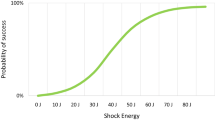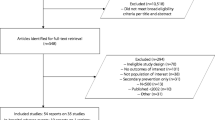Abstract
The results of the MADIT II study have generated a great deal of controversy in the world of electrophysiology. Much of the controversy appears related to the sheer numbers of potential Implantable Cardioverter Defibrillator (ICD) implants and their potential cost to the healthcare system. Two federal regulatory agencies, the Food and Drug Administration (FDA) and the Centers for Medicare and Medicaid Services (CMS) have been highly visible in discussions. The FDA approved the MADIT II indications for Guidant ICDs, while CMS covered a limited subset of the patients studied. This review explores some the issues surrounding the trial and the key participants in this discussion with emphasis on the role of the Food and Drug Administration (FDA) and how regulatory decisions may impact on clinical practice.
Similar content being viewed by others
References
Moss AJ, Zareba W, Hall WJ, Klein H, Wilber DJ, Cannom DS, Daubert JP, Higgins SL, Brown MW, Andrews ML. Prophylactic implantation of a defibrillator in patients with myocardial infarction and reduced ejection fraction. N Engl J Med 2002;346:877–883.
Summary of Safety and Effectiveness for Guidant ICDs included in MADIT II. http://www.fda.gov/cdrh/ df/P910077S037b.pdf. Accessed September 1, 2003
GregoratosG, Abrams J, Epstein AE, Freedman RA, Hayes DL, Hlatky MA, Kerber RE, NaccarelliGV, Schoenfled MH, Silka MJ, Winters SL. ACC/AHA/NASPE 2002 guideline update for implantation of cardiac pacemakers and antiarrhythmia devices: Summary article: A report of the American College of Cardiology/American Heart Association Task Force on Practice Guidelines (ACC/AHA/NASPE Committee to update the 1998 Pacemaker Guidelines). Circulation 2002;106:2145–2161.
Transcript for Centers for Medicare and Medicaid Services Medicare Coverage Advisory Committee February 12, 2003. http://www.cms.hhs.gov/mcac/id39-5.pdf. Accessed on September 17, 2003
National Coverage Analysis (NCA) Implantable Cardioverter Defibrillators (ICDs) (#CAG-00157N) Tracking Sheet. http://www.cms.hhs.gov/ncdr/trackingsheet.asp? id = 39. Accessed September 15, 2003
Moss AJ, Hall WJ, Cannom DS, Daubert JP, Higgins SL, Klein H, Levine JH, Saksena S, Waldo AL, Wilber D, Brown MW, Heo M. Improved survival with an implantable de-fibrillator in patients with coronary disease at high risk for ventricular arrhythmia. N Engl J Med 1996;335:1933–1940.
The Antiarrhythmics Versus Implantable Defibrillators (AVID) Investigators. A comparison of antiarrhythmicdrug therapy with implantable defibrillators in patients resuscitated from near-fatal ventricular arrhythmias. N Engl J Med 1997;337:1576–1583.
Author information
Authors and Affiliations
Rights and permissions
About this article
Cite this article
Barold, H.S. Using the MADIT II Criteria for Implantable Cardioverter Defibrillators—What is the Role of the Food and Drug Administration Approval?. Card Electrophysiol Rev 7, 443–446 (2003). https://doi.org/10.1023/B:CEPR.0000023166.65777.6f
Issue Date:
DOI: https://doi.org/10.1023/B:CEPR.0000023166.65777.6f




